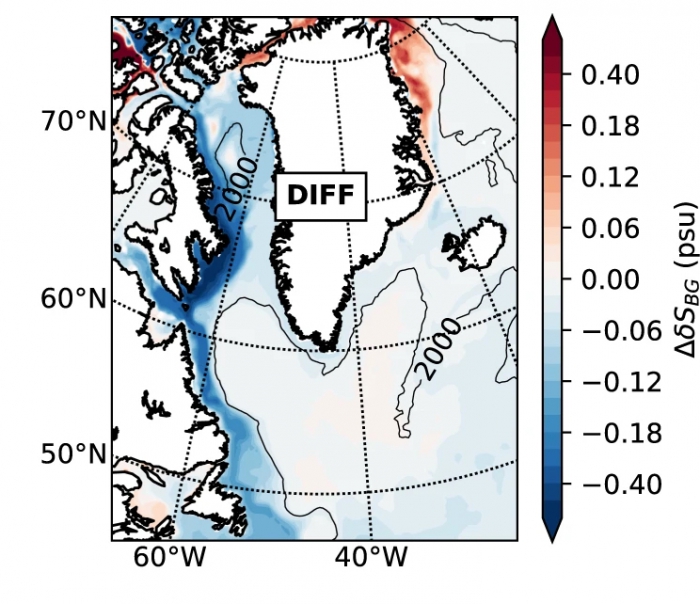By: Jiaxu Zhang, Cooperative Institute for Climate, Ocean, and Ecosystem Studies, University of Washington and NOAA Pacific Marine Environmental Laboratory; Wilbert Weijer, Los Alamos National Laboratory; Michael Steele, Polar Science Center, Applied Physics Lab, University of Washington; and Wei Cheng, Cooperative Institute for Climate, Ocean, and Ecosystem Studies, University of Washington and NOAA Pacific Marine Environmental Laboratory
The Arctic Ocean, which is the freshest ocean in the world, is getting even fresher with the changing climate. This is because the Russian and North American rivers draining to the north are increasing their input. In addition, the relatively fresh ocean waters that flow north through the Bering Strait from the North Pacific Ocean are getting fresher. Eventually, this freshwater (both liquid ocean water and solid sea ice) finds its way south into the North Atlantic Ocean via the complex passageways of the Canadian Arctic Archipelago and also through Fram Strait northeast of Greenland. But how and where this water will flow into the Atlantic Ocean, and what ocean-cryosphere feedbacks are invoked as a result, is not well understood.
Starting in October 2018, a collaborative project entitled, "Arctic freshwater pathways and their impact on North Atlantic deep water formation in a hierarchy of models," conducted by University of Washington and Los Alamos National Laboratory scientists and funded by the National Oceanic and Atmospheric Administration (NOAA) Climate Program Office's Climate Variability & Predictability and the Department of Energy's Earth and Environmental System Modeling Program, was launched to dig into the problem. The goal is to investigate freshwater pathways—both oceanic and ice—between the Arctic and subpolar North Atlantic, their controlling mechanisms, and interactions with the Atlantic Meridional Overturning Circulation (AMOC)—that great flow of surface water moving northward that overturns in the North Atlantic and heads south again at great depth. The project utilizes numerical modeling techniques developed at the Los Alamos National Laboratory, as well as available observational data.
The team has been focusing on the Beaufort Sea, the Arctic Ocean's largest freshwater reservoir, which has increased its freshwater content by 40% over the last two decades. A study led by Dr. Jiaxu Zhang, and published in February 2021's issue of Nature Communications, aimed to understand what the potential implications of a rapid release of this Beaufort Sea freshwater may be by looking at historical episodes in which large amounts of freshwater were released.

The team found that this freshwater travels through the Canadian Arctic Archipelago to reach the Labrador Sea, rather than through the much wider Fram Strait to the Nordic Seas. The authors also found that a strong freshening occurred in the western Labrador Sea shelves during a release event in the 1980s. This freshening is found to be comparable in magnitude with that resulting from Greenland meltwater, which is another important freshwater source of the Labrador Sea.

The finding has implications for the Labrador Sea marine environment and the shelf ecosystem, since subsurface Beaufort Sea freshwater is rich in nutrients. The freshening found in the western Labrador Sea shelves could also affect the AMOC, because relatively fresh water tends to float on top of the saline water, making it harder to sink. However, the exact effect was not studied and is still unknown.
The AMOC is decreasing and has recently been found to be weaker than at any point in the last 1,000 years. Changes in this flow would significantly impact the European weather system as well as coastal floodings to the US eastern seaboard. If the AMOC continues to decrease, the consequences would be ominous.
Considering the current Beaufort Sea freshwater storage is abnormally large at more than 23,300 cubic kilometers—twice the size of the historical event studied here—the impact of a future release on Labrador Sea salinity could be significant, easily exceeding perturbation from Greenland meltwater.
The published study focused on past events. Current research is looking at the vertical structure of the Beaufort Sea in detail over a longer period of time, trying to understand where today's freshwater buildup might end up. Two additional topics are under investigation in the project. One is to develop advanced measures of freshwater content for model diagnosis. Another is to explore water mass properties along the OSNAP (Overturning in the Subpolar North Atlantic) transect and their linkage to AMOC variability. Through the research portfolio, the team aims to build a better understanding of the processes that teleconnect the Arctic Ocean with the North Atlantic Ocean in a rapidly changing climate.
Citations
Zhang, J., Weijer, W., Steele, M., Cheng W., Verma T., Veneziani M. 2021. Labrador Sea freshening linked to Beaufort Gyre freshwater release. Nature Communications 12:1229 https://doi.org/10.1038/s41467-021-21470-3
Zhang, J. et al. 2019. An eddy-permitting ocean-sea ice general circulation model (E3SMv0-HiLAT03): Description and evaluation. Technical Report (Los Alamos National Laboratory, Los Alamos, NM, United States). https://doi.org/10.2172/1542803
About the Authors
 Jiaxu Zhang is a Postdoc Scholar at the Cooperative Institute for Climate, Ocean and Ecosystem Studies in University of Washington and NOAA Pacific Marine Environmental Laboratory. She is interested in global/regional ocean modeling and high-latitude ocean dynamics. Contact her via email (jiaxuzh [at] uw.edu).
Jiaxu Zhang is a Postdoc Scholar at the Cooperative Institute for Climate, Ocean and Ecosystem Studies in University of Washington and NOAA Pacific Marine Environmental Laboratory. She is interested in global/regional ocean modeling and high-latitude ocean dynamics. Contact her via email (jiaxuzh [at] uw.edu).
 Wilbert Weijer (project co-PI) is staff scientist at Los Alamos National Laboratory, in Los Alamos, New Mexico. He is a physical oceanographer and leads the HiLAT (HiLAT Latitude Application and Testing of Earth System Models) Science Focus Area (SFA) for the Department of Energy's Office of Science. Contact him via email (wilbert [at] lanl.gov).
Wilbert Weijer (project co-PI) is staff scientist at Los Alamos National Laboratory, in Los Alamos, New Mexico. He is a physical oceanographer and leads the HiLAT (HiLAT Latitude Application and Testing of Earth System Models) Science Focus Area (SFA) for the Department of Energy's Office of Science. Contact him via email (wilbert [at] lanl.gov).
 Michael Steele (project co-PI) is a Senior Principal Oceanographer at the Polar Science Center, Applied Physics Lab, University of Washington. He studies the dynamics and thermodynamics of the Arctic Seas. Contact him via email (mas [at] apl.washington.edu).
Michael Steele (project co-PI) is a Senior Principal Oceanographer at the Polar Science Center, Applied Physics Lab, University of Washington. He studies the dynamics and thermodynamics of the Arctic Seas. Contact him via email (mas [at] apl.washington.edu).
 Wei Cheng (project PI) is a Physical Oceanographer with the University of Washington/Cooperative Institute for Climate, Ocean, and Ecosystem Studies and NOAA Pacific Marine Environmental Laboratory. She studies ocean circulation and ocean's role in the global and regional climate system. She can be reached at wei.cheng [at] noaa.gov.
Wei Cheng (project PI) is a Physical Oceanographer with the University of Washington/Cooperative Institute for Climate, Ocean, and Ecosystem Studies and NOAA Pacific Marine Environmental Laboratory. She studies ocean circulation and ocean's role in the global and regional climate system. She can be reached at wei.cheng [at] noaa.gov.
